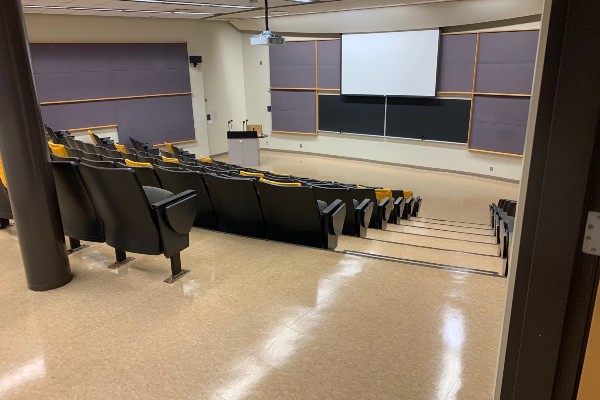Holding limited in-person classes
September 23, 2020
Share

When Queen’s decided to move courses online for the fall due to COVID-19, it also took up the challenge of finding ways to safely hold a few small classes in person for select programs. Now with extensive health and safety guidelines in place, the university is welcoming a small number of students and instructors back to campus.
“Promoting health and safety during the pandemic is the top priority of the university at this time, which is why the vast majority of classes in the fall will be delivered remotely. But where possible we also wanted to preserve in-person education for some courses and programs,” says John Pierce, Vice-Provost (Teaching and Learning). “Our guidelines for classroom use are making it possible for students and instructors to follow public health protocols while meeting in person on campus.”
Approximately 80 small classes have been approved to meet on campus. These courses come primarily from the Faculty of Health Sciences, the School of Graduate Studies, and some professional programs.
The university has put many precautions in place to ensure that all class participants can keep two metres of physical distance. Most of these small classes are being held in large lecture halls that are operating at a significantly reduced capacity. Markers on seats show students which seats are available for use, and all available seats are at least two metres apart from each other.
Students are required to wear a mask at all times while they are inside a campus building. If students are unable to wear masks under the KFL&A Public Health pandemic order exemptions, they should advise their instructors and instructors must offer them the ability to complete the class remotely. Instructors should not send these students to Queen's Student Accessibility Services to request a formal accommodation, but should accept a student's request in good faith and respond appropriately.
Lecturing instructors do not need to wear masks, but they are able to maintain physical distance by standing behind the plexiglass shield at the front of the podium. Instructors are also asked to start and end classes at designated times, so students can maintain physical distance while entering and exiting.
All classrooms will be cleaned thoroughly once a day, and hand sanitizer and disinfectant wipes will be available in all classrooms. Students and instructors should sanitize their hands and wipe down chairs and tables at the start of each class.
When students approach a classroom, they will see guidelines for using the room posted on the door. And there will also be floor decals spaced two metres apart to help them maintain physical distance if they need to wait to enter a class.
Most campus buildings will remain locked throughout the fall. Buildings that hold courses will be unlocked only for the class. The doors will unlock 30 minutes before the start of the class, and they will lock again 30 minutes after the class begins. Classrooms are to be used for approved classes only.
These classroom guidelines are a part of the university’s overall return-to-campus strategy, which seeks the safe, responsible, and gradual return to normal operations, as Public Health guidelines permit. As part of this effort, the university is continuing with remote delivery of classes this fall for most students, limiting the capacity of campus residences to under 50 per cent, making face masks mandatory, and ensuring physical distancing. As recently announced, such plans will continue into the winter term. Queen’s has begun a phased reopening of the Athletics and Recreation Centre with new health and safety protocols in place, and has added a COVID-19 assessment tool to its on-campus mobile safety app, SeQure.
Everyone is also encouraged to follow hand hygiene, mask wearing, physical distancing, and other public health guidance to limit COVID-19 spread.
For more information on the university’s COVID-19 planning and resources, visit the COVID-19 Information website.